Page 10 of 482
JVO0058X
1. Front view camera* (P.4-29)
2. Hood (P.3-25)
3. Windshield wiper and washer— Switch operation (P.2-30)
— Blade replacement (P.8-17)
— Window washer fluid (P.8-13)
4. Moonroof* (P.2-53) 5. Outside mirrors (P.3-35)
- Side view camera* (P.4-29)
6. Power windows (P.2-51)
7. Side turn signal light* — Switch operation (P.2-37)
— Bulb replacement (P.8-27)
8. Roof rack (rail)* (P.2-49) 9. Recovery hook (P.6-16)
10. License plate installation (P.9-11)
11. Fog lights*
— Switch operation (P.2-38)
— Bulb replacement (P.8-27)
12. Headlight and turn signal lights — Switch operation (P.2-33)
— Bulb replacement (P.8-27)
13. Tires — Wheel and tires (P. 8-30, P.9-7)
— Flat tire (P.6-3)
— Tire Pressure Monitoring System (TPMS)
(P.2-14, P.5-3)
14. Doors — Keys (P.3-3)
— Door locks (P.3-5)
— Intelligent Key system (P.3-13)
— Security system (P.2-27)
15. Child safety rear door lock (P.3-9)
16. Sliding doors (P.3-7)
*: if so equipped
Illustrated table of contents0-3
EXTERIOR FRONT
Page 17 of 482
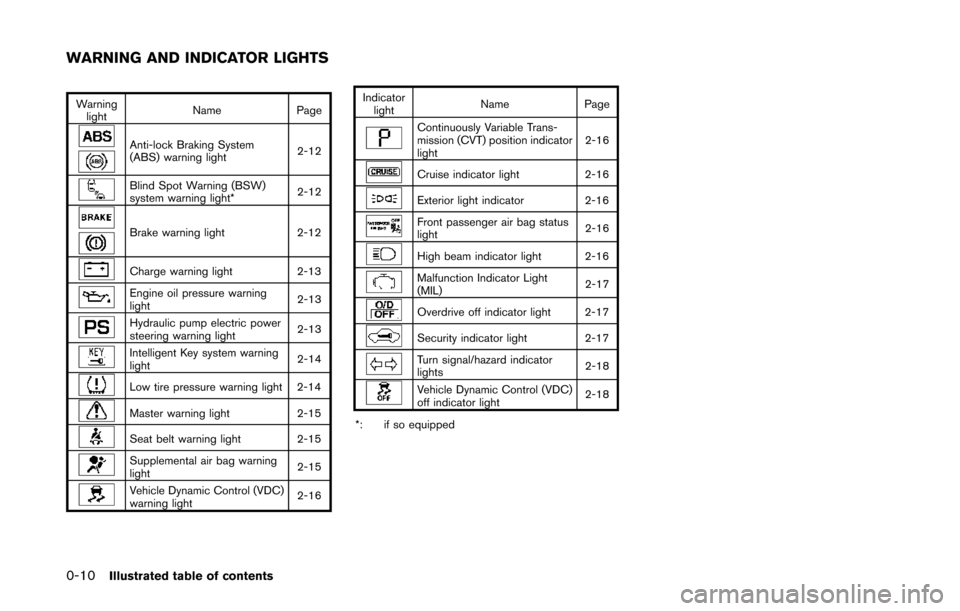
0-10Illustrated table of contents
Warninglight Name
Page
Anti-lock Braking System
(ABS) warning light 2-12
Blind Spot Warning (BSW)
system warning light*2-12
Brake warning light
2-12
Charge warning light2-13
Engine oil pressure warning
light 2-13
Hydraulic pump electric power
steering warning light2-13
Intelligent Key system warning
light2-14
Low tire pressure warning light 2-14
Master warning light
2-15
Seat belt warning light 2-15
Supplemental air bag warning
light 2-15
Vehicle Dynamic Control (VDC)
warning light2-16Indicator
light Name Page
Continuously Variable Trans-
mission (CVT) position indicator
light 2-16
Cruise indicator light
2-16
Exterior light indicator2-16
Front passenger air bag status
light 2-16
High beam indicator light 2-16
Malfunction Indicator Light
(MIL)2-17
Overdrive off indicator light 2-17
Security indicator light
2-17
Turn signal/hazard indicator
lights 2-18
Vehicle Dynamic Control (VDC)
off indicator light2-18
*: if so equipped
WARNING AND INDICATOR LIGHTS
Page 19 of 482

1-2Safety — Seats, seat belts and supplemental restraint system
SSS0133
WARNING
.Do not ride in a moving vehicle
when the seatback is reclined. This
can be dangerous. The shoulder belt
will not be against your body. In an
accident, you could be thrown into it
and receive neck or other serious
injuries. You could also slide under
the lap belt and receive serious
internal injuries.
. For the most effective protection
when the vehicle is in motion, the
seat should be upright. Always sit well back in the seat with both feet
on the floor and adjust the seat belt
properly. See “Precautions on seat
belt usage” (P.1-15) .
. After adjustment, gently rock in the
seat to make sure it is securely
locked.
. Do not leave children unattended
inside the vehicle. They could un-
knowingly activate switches or con-
trols. Unattended children could
become involved in serious acci-
dents. .
Do not adjust the driver’s seat while
driving so full attention may be
given to vehicle operation. The seat
may move suddenly and could
cause loss of control of the vehicle.
. The seatback should not be reclined
any more than needed for comfort.
Seat belts are most effective when
the passenger sits well back and
straight up in the seat. If the seat-
back is reclined, the risk of sliding
under the lap belt and being injured
is increased.
SEATS
Page 24 of 482
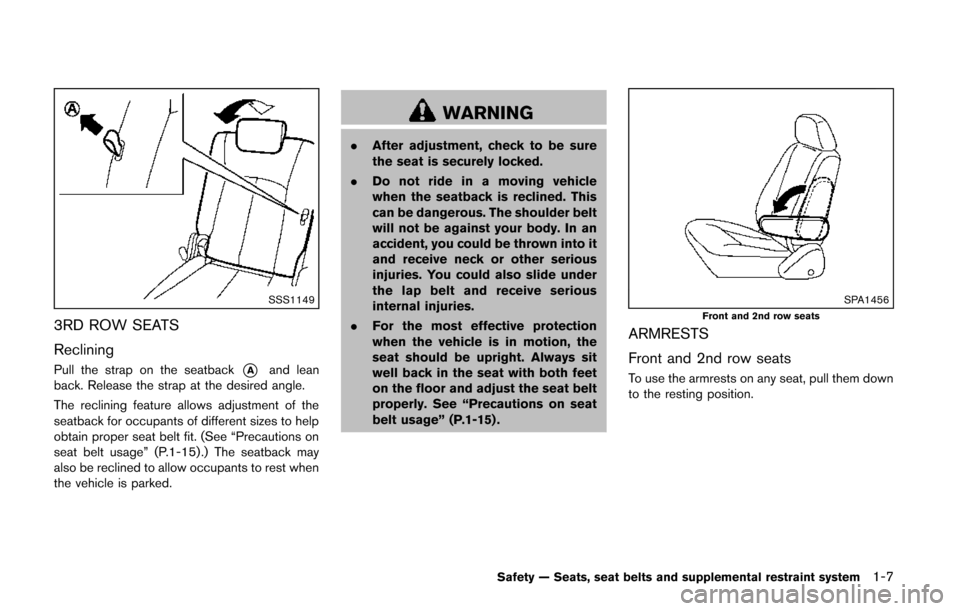
SSS1149
3RD ROW SEATS
Reclining
Pull the strap on the seatback*Aand lean
back. Release the strap at the desired angle.
The reclining feature allows adjustment of the
seatback for occupants of different sizes to help
obtain proper seat belt fit. (See “Precautions on
seat belt usage” (P.1-15) .) The seatback may
also be reclined to allow occupants to rest when
the vehicle is parked.
WARNING
. After adjustment, check to be sure
the seat is securely locked.
. Do not ride in a moving vehicle
when the seatback is reclined. This
can be dangerous. The shoulder belt
will not be against your body. In an
accident, you could be thrown into it
and receive neck or other serious
injuries. You could also slide under
the lap belt and receive serious
internal injuries.
. For the most effective protection
when the vehicle is in motion, the
seat should be upright. Always sit
well back in the seat with both feet
on the floor and adjust the seat belt
properly. See “Precautions on seat
belt usage” (P.1-15) .
SPA1456Front and 2nd row seats
ARMRESTS
Front and 2nd row seats
To use the armrests on any seat, pull them down
to the resting position.
Safety — Seats, seat belts and supplemental restraint system1-7
Page 25 of 482
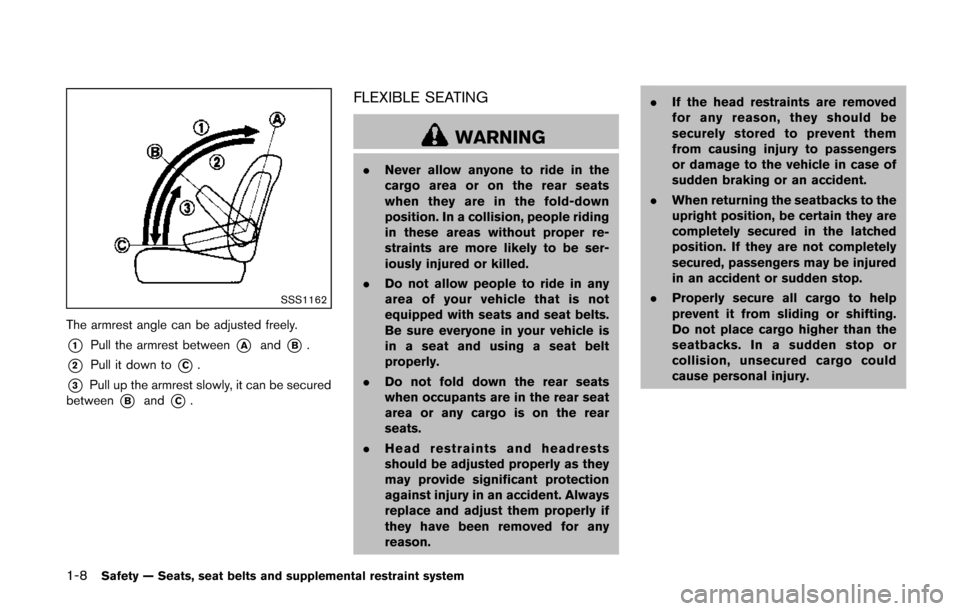
1-8Safety — Seats, seat belts and supplemental restraint system
SSS1162
The armrest angle can be adjusted freely.
*1Pull the armrest between*Aand*B.
*2Pull it down to*C.
*3Pull up the armrest slowly, it can be secured
between
*Band*C.
FLEXIBLE SEATING
WARNING
. Never allow anyone to ride in the
cargo area or on the rear seats
when they are in the fold-down
position. In a collision, people riding
in these areas without proper re-
straints are more likely to be ser-
iously injured or killed.
. Do not allow people to ride in any
area of your vehicle that is not
equipped with seats and seat belts.
Be sure everyone in your vehicle is
in a seat and using a seat belt
properly.
. Do not fold down the rear seats
when occupants are in the rear seat
area or any cargo is on the rear
seats.
. Head restraints and headrests
should be adjusted properly as they
may provide significant protection
against injury in an accident. Always
replace and adjust them properly if
they have been removed for any
reason. .
If the head restraints are removed
for any reason, they should be
securely stored to prevent them
from causing injury to passengers
or damage to the vehicle in case of
sudden braking or an accident.
. When returning the seatbacks to the
upright position, be certain they are
completely secured in the latched
position. If they are not completely
secured, passengers may be injured
in an accident or sudden stop.
. Properly secure all cargo to help
prevent it from sliding or shifting.
Do not place cargo higher than the
seatbacks. In a sudden stop or
collision, unsecured cargo could
cause personal injury.
Page 26 of 482
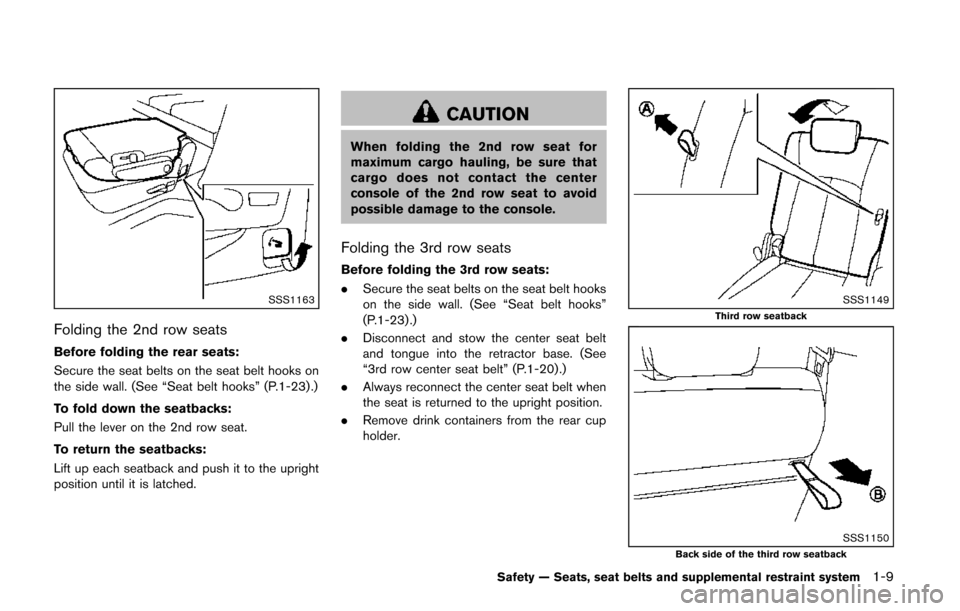
SSS1163
Folding the 2nd row seats
Before folding the rear seats:
Secure the seat belts on the seat belt hooks on
the side wall. (See “Seat belt hooks” (P.1-23) .)
To fold down the seatbacks:
Pull the lever on the 2nd row seat.
To return the seatbacks:
Lift up each seatback and push it to the upright
position until it is latched.
CAUTION
When folding the 2nd row seat for
maximum cargo hauling, be sure that
cargo does not contact the center
console of the 2nd row seat to avoid
possible damage to the console.
Folding the 3rd row seats
Before folding the 3rd row seats:
.Secure the seat belts on the seat belt hooks
on the side wall. (See “Seat belt hooks”
(P.1-23) .)
. Disconnect and stow the center seat belt
and tongue into the retractor base. (See
“3rd row center seat belt” (P.1-20) .)
. Always reconnect the center seat belt when
the seat is returned to the upright position.
. Remove drink containers from the rear cup
holder.
SSS1149Third row seatback
SSS1150Back side of the third row seatback
Safety — Seats, seat belts and supplemental restraint system1-9
Page 28 of 482
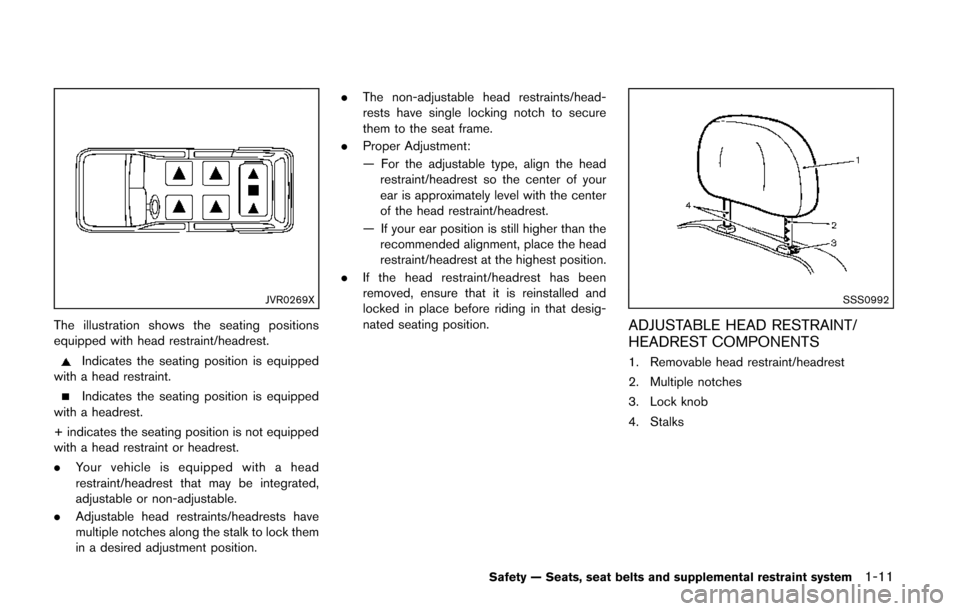
JVR0269X
The illustration shows the seating positions
equipped with head restraint/headrest.
Indicates the seating position is equipped
with a head restraint.
Indicates the seating position is equipped
with a headrest.
+ indicates the seating position is not equipped
with a head restraint or headrest.
. Your vehicle is equipped with a head
restraint/headrest that may be integrated,
adjustable or non-adjustable.
. Adjustable head restraints/headrests have
multiple notches along the stalk to lock them
in a desired adjustment position. .
The non-adjustable head restraints/head-
rests have single locking notch to secure
them to the seat frame.
. Proper Adjustment:
— For the adjustable type, align the head
restraint/headrest so the center of your
ear is approximately level with the center
of the head restraint/headrest.
— If your ear position is still higher than the recommended alignment, place the head
restraint/headrest at the highest position.
. If the head restraint/headrest has been
removed, ensure that it is reinstalled and
locked in place before riding in that desig-
nated seating position.
SSS0992
ADJUSTABLE HEAD RESTRAINT/
HEADREST COMPONENTS
1. Removable head restraint/headrest
2. Multiple notches
3. Lock knob
4. Stalks
Safety — Seats, seat belts and supplemental restraint system1-11
Page 29 of 482
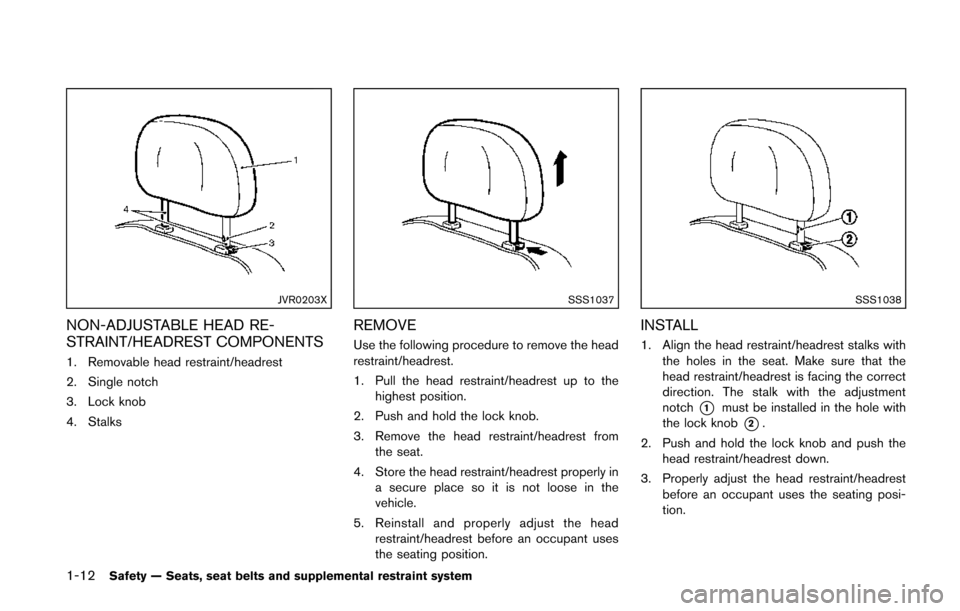
1-12Safety — Seats, seat belts and supplemental restraint system
JVR0203X
NON-ADJUSTABLE HEAD RE-
STRAINT/HEADREST COMPONENTS
1. Removable head restraint/headrest
2. Single notch
3. Lock knob
4. Stalks
SSS1037
REMOVE
Use the following procedure to remove the head
restraint/headrest.
1. Pull the head restraint/headrest up to thehighest position.
2. Push and hold the lock knob.
3. Remove the head restraint/headrest from the seat.
4. Store the head restraint/headrest properly in a secure place so it is not loose in the
vehicle.
5. Reinstall and properly adjust the head restraint/headrest before an occupant uses
the seating position.
SSS1038
INSTALL
1. Align the head restraint/headrest stalks with
the holes in the seat. Make sure that the
head restraint/headrest is facing the correct
direction. The stalk with the adjustment
notch
*1must be installed in the hole with
the lock knob
*2.
2. Push and hold the lock knob and push the head restraint/headrest down.
3. Properly adjust the head restraint/headrest before an occupant uses the seating posi-
tion.